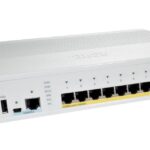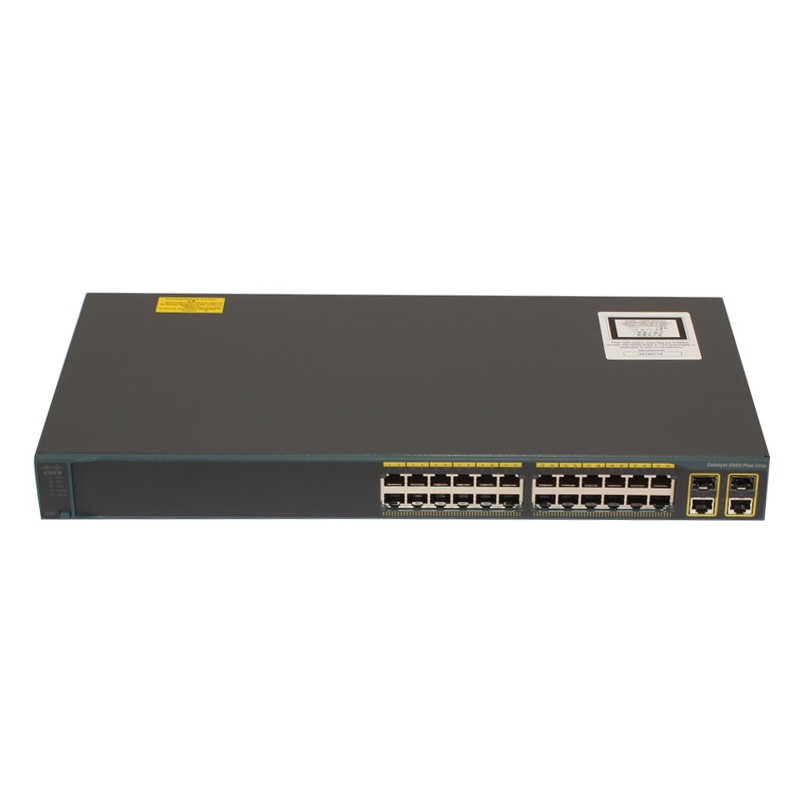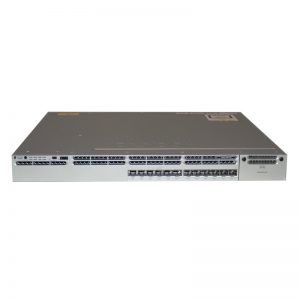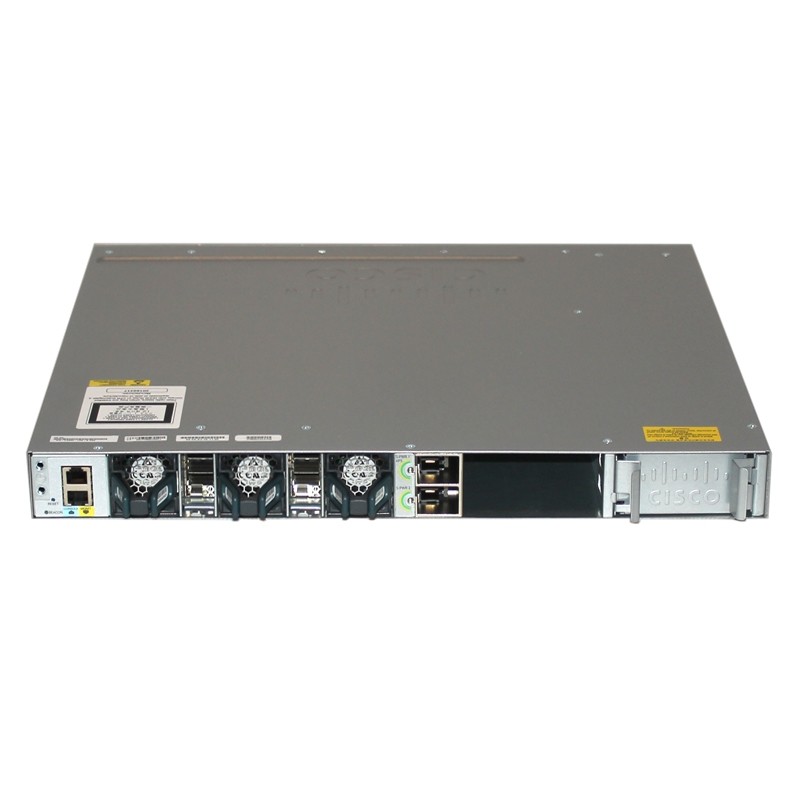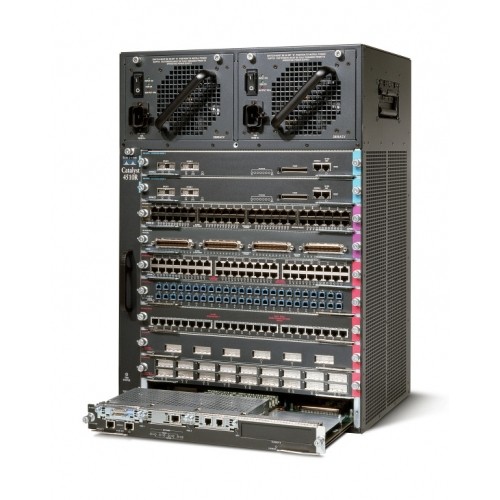

N5K-C5548UP-FA
$32,200.00 Original price was: $32,200.00.$7,555.00Current price is: $7,555.00.
| Model: |
N5K-C5548UP-FA – Cisco Nexus 5000 Series Switch |
| Detail: |
Nexus 5548UP Chassis, 32 10GbE Ports, Bundle 2 PS, 2 Fans |
Gear Net Technologies Present server farms are progressively loaded up with thick rack-mount and sharp edge workers that have amazing multicore processors. The fast expansion in-rack processing thickness and the expanding utilization of virtualization programming join to quicken the interest for 10 Gigabit Ethernet and combined I/O: applications for which the Cisco Nexus 5000 arrangement switches are a fantastic match. With low inactivity, front-to-back cooling, and back confronting information ports, the Cisco Nexus 5000 arrangement is intended for a wide scope of physical, virtual, capacity access, and elite figuring conditions, accordingly giving clients the adaptability to meet and scale their server farm necessities in a continuous way and at a speed that lines up with their business destinations.
Cisco switch arrangement, utilizing slice through design, upholds line-rate 10 Gigabit Ethernet on all ports while keeping up reliably low inertness free of parcel size and administrations empowered. It bolsters a bunch of organization advancements referred to altogether as Data.
Main Features
Switch
managed
32 x SFP+
rack-mountable
- Description
Description
N5K-C5548UP-FA Specifications |
|
| Performance N5K-C5548UP-FA | ● Layer 2 hardware forwarding at 960 Gbps or 714.24 mpps; Layer 3 performance of up to 160 Gbps or 240 mpps
● MAC address table entries: 32,000 ● Low-latency cut-through design that provides predictable, consistent traffic latency regardless of packet size, traffic pattern, or enabled features on 10 Gigabit Ethernet interfaces ● Line-rate traffic throughput on all ports |
| Interfaces | ● 32 fixed ports configurable as 1 and 10 Gigabit Ethernet and FCoE or 8/4/2/1-Gbps native Fiber Channel; additional interfaces through one expansion module
● Expansion modules ● 16-port 1 and 10 Gigabit Ethernet and FCoE module ● 8-port 8/4/2/1-Gbps Fibre Channel plus 8-port 1 and 10 Gigabit Ethernet and FCoE module ● Unified port module consisting of 16 ports configurable as 8/4/2/1-Gbps Fibre Channel or 1 and 10 Gigabit Ethernet and FCoE ● 4-port QSFP expansion module ● 12-port 10G BASE-T module (Cisco Nexus 5596T only) ● Layer 3 module (Cisco Nexus 5596UP and 5596T only; one per system) ● Layer 3 daughter card (Cisco Nexus 5548P and 5548UP only; one per system) ● Extension through the Cisco Nexus 2000 Series |
| Layer 2 Features | ● Layer 2 switch ports and VLAN trunks
● IEEE 802.1Q VLAN encapsulation ● Support for up to 4096 VLANs ● Rapid Per-VLAN Spanning Tree Plus (PVRST+) (IEEE 802.1w compatible) ● Multiple Spanning Tree Protocol (MSTP) (IEEE 802.1s): 64 instances ● Spanning Tree PortFast ● Spanning Tree root guard ● Spanning Tree Bridge Assurance ● Cisco EtherChannel technology (up to 16 ports per EtherChannel) ● Cisco vPC technology ● Enhanced PC enable PC between Cisco Nexus 5000 and 2000 Series as well as between Cisco Nexus 3000 Series and end host ● PC configuration synchronization ● Link Aggregation Control Protocol (LACP): IEEE 802.3ad ● Advanced port channel hashing based on Layer 2, 3, and 4 information ● Jumbo frames on all ports (up to 9216 bytes) ● Pause frames (IEEE 802.3x) ● Storm control (unicast, multicast, and broadcast) ● Private VLANs ● Private VLAN over trunks (isolated and promiscuous) ● Private VLANs over vPC and EtherChannels ● VLAN Remapping ● Cisco FabricPath ● EvPC and vPC+ with FabricPath ● Cisco Adapter FEX ● Cisco Data Center VM FEX ● Support for up to 24 fabric extenders on each Cisco Nexus 5500 platform |
| Layer 3 Features | ● Layer 3 interfaces: Routed ports on Cisco Nexus 5500 platform interfaces, switch virtual interface (SVI), port channels, subinterfaces, and port channel subinterfaces for a total of 4096 entries
● Support for up to 8000 prefixes and up to 16000 IPv4 and 8000 IPv6 host entries ● Support for up to 8000 multicast routes ● Support for up to 8000 IGMP groups ● Support for 1000 VRF entries ● Support for up to 4096 VLANs ● 16-way equal-cost multipathing (ECMP) ● 1664 ingress and 2048 egress access control list (ACL) entries ● Routing protocols: Static, Routing Information Protocol Version2 (RIPv2), Enhanced Interior Gateway Routing Protocol (EIGRP), Open Shortest Path First Version 2 (OSPFv2), and Border Gateway Protocol (BGP) ● IPv6 Routing Protocols: Static, Open Shortest Path First Version 3 (OPFv3), Border Gateway Protocol (BGPv6), Enhanced Interior Gateway Routing Protocol (EIGRPv6) ● IPv6 VRF Lite ● Hot-Standby Router Protocol (HSRP) and Virtual Router Redundancy Protocol (VRRP) ● ACL: Routed ACL with Layer 3 and 4 options to match ingress and egress ACL ● Multicast: Protocol Independent Multicast Version 2 (PIMv2) sparse mode, Source Specific Multicast (SSM), Multicast Source Discovery Protocol (MSDP), Internet Group Management Protocol Versions 2, and 3 (IGMP v2, and v3), and Multicast VLAN Registration (MVR) ● Virtual Route Forwarding (VRF): VRF-lite (IP VPN); VRF-aware unicast; and BGP-, OSPF-, RIP-, and VRF-aware multicast ● Unicast Reverse Path Forwarding (uRFP) with ACL; strict and loose modes ● Jumbo frame support (up to 9216 bytes) ● Support for up to 16 fabric extender on each Nexus 5500 with L3 modules ● RFC 896 |
| QoS | ● Layer 2 IEEE 802.1p (CoS)
● 8 hardware queues per port ● Per-port QoS configuration ● CoS trust ● Port-based CoS assignment ● Modular QoS CLI (MQC) compliance – IPv4 and IPv6 ● ACL-based QoS classification (Layers 2, 3, and 4) ● MQC CoS marking ● Per-port virtual output queuing ● CoS-based egress queuing ● Egress strict-priority queuing ● Egress port-based scheduling: Weighted Round-Robin (WRR) ● Control Plan Policing (CoPP) – IPv4 and IPv6 |
| Security N5K-C5548UP-FA | ● Ingress ACLs (standard and extended) on Ethernet and virtual Ethernet ports
● Standard and extended Layer 2 ACLs: MAC addresses, protocol type, etc. ● Standard and extended Layer 3 to 4 ACLs: IPv4 and IPv6, Internet Control Message Protocol (ICMP and ICMPv6), TCP, User Datagram Protocol (UDP), etc. ● VLAN-based ACLs (VACLs) ● Port-based ACLs (PACLs) ● Named ACLs ● Optimized ACL distribution ● ACLs on virtual terminals (VTYs) ● ACL logging on management interface ● Dynamic Host Configuration Protocol (DHCP) snooping with Option 82 ● Dynamic Address Resolution Protocol (ARP) Inspection ● IP source guard ● DHCP relay ● Cisco CTS (Authentication and Policy download from ACS) ● Ethernet Port Security ● IPv6 RACL ● IPv6 PACL ● IPv6 VACL |
| High-Availability Features | ● In-Service Software Upgrade (ISSU) for Layer 2
● Hot-swappable field-replaceable power supplies, fan modules, and expansion modules ● 1:1 power redundancy ● N:1 fan module redundancy |
| Management | ● Switch management using 10/100/1000-Mbps management or console ports
● CLI-based console to provide detailed out-of-band management ● In-band switch management ● Locator and beacon LEDs on Cisco Nexus 2000 Series ● Port-based locator and beacon LEDs ● Configuration synchronization ● Module preprovisioning ● Configuration rollback ● Secure Shell Version 2 (SSHv2) ● Telnet ● AAA ● AAA with RBAC ● RADIUS ● TACACS+ ● Syslog (8 servers) ● Embedded packet analyzer ● SNMPv1, v2, and v3 (IPv4 & IPv6) ● Enhanced SNMP MIB support ● XML (NETCONF) support ● Remote monitoring (RMON) ● Advanced Encryption Standard (AES) for management traffic ● Unified username and passwords across CLI and SNMP ● Microsoft Challenge Handshake Authentication Protocol (MS-CHAP) ● Digital certificates for management between switch and RADIUS server ● Cisco Discovery Protocol Versions 1 and 2 ● RBAC ● Switched Port Analyzer (SPAN) on physical, port channel, VLAN, and Fibre Channel interfaces ● Encapsulated Remote SPAN (ERSPAN) ● Ingress and egress packet counters per interface ● Network Time Protocol (NTP) ● Cisco GOLD ● Comprehensive bootup diagnostic tests ● Call Home ● Smart Call Home ● Cisco Fabric Manager ● Cisco DCNM ● CiscoWorks LAN Management Solution (LMS) |
| Data Center Bridging | ● CEE- and IEEE-compliant PFC (per-priority Pause frame support)
● PFC link distance support: 3000m ● CEE-compliant DCBX Protocol ● CEE- and IEEE-compliant Enhanced Transmission Selection |
| Fibre Channel and FCoE Features (Requires Storage Services License) | ● T11 standards-compliant FCoE (FC-BB-5)
● T11 FCoE Initialization Protocol (FIP) (FC-BB-5) ● Any 10 Gigabit Ethernet port configurable as FCoE ● SAN administration separate from LAN administration ● FCP ● Fibre Channel forwarding (FCF) ● Fibre Channel standard port types: E, F, and NP ● Fibre Channel enhanced port types: VE, TE, and VF ● F-port trunking ● F-port channeling ● Direct attachment of FCoE and Fibre Channel targets ● Up to 240 buffer credits per native Fibre Channel port ● Up to 32 VSANs per switch ● Fibre Channel (SAN) port channel ● Native Interop Mode 1 ● Native Interop Mode 2 ● Native Interop Mode 3 ● Native Interop Mode 4 ● VSAN trunking ● Fabric Device Management Interface (FDMI) ● Fibre Channel ID (FCID) persistence ● Distributed device alias services ● In-order delivery ● Port tracking ● Cisco N-Port Virtualization (NPV) technology ● N-port identifier virtualization (NPIV) ● Fabric services: Name server, registered state change notification (RSCN), login services, and name-server zoning ● Per-VSAN fabric services ● Cisco Fabric Services ● Diffie-Hellman Challenge Handshake Authentication Protocol (DH-CHAP) and Fibre Channel Security Protocol (FC-SP) ● Distributed device alias services ● Host-to-switch and switch-to-switch FC-SP authentication ● Fabric Shortest Path First (FSPF) ● Fabric binding for Fibre Channel ● Standard zoning ● Port security ● Domain and port ● Enhanced zoning ● SAN port channels ● Cisco Fabric Analyzer ● Fibre Channel traceroute ● Fibre Channel ping ● Fibre Channel debugging ● Cisco Fabric Manager support ● Storage Management Initiative Specification (SMI-S) ● Boot from SAN over VPC/EVPC |
| Generic MIBs | ● SNMPv2-SMI
● CISCO-SMI ● SNMPv2-TM ● SNMPv2-TC ● IANA-ADDRESS-FAMILY-NUMBERS-MIB ● IANAifType-MIB ● IANAiprouteprotocol-MIB ● HCNUM-TC ● CISCO-TC ● SNMPv2-MIB ● SNMP-COMMUNITY-MIB ● SNMP-FRAMEWORK-MIB ● SNMP-NOTIFICATION-MIB ● SNMP-TARGET-MIB ● SNMP-USER-BASED-SM-MIB ● SNMP-VIEW-BASED-ACM-MIB ● CISCO-SNMP-VACM-EXT-MIB |
| Layer 3 MIBs N5K-C5548UP-FA | ● UDP-MIB
● TCP-MIB ● OSPF-MIB ● BGP4-MIB ● CISCO-HSRP-MIB |
| Fibre Channel MIBs | ● CISCO-ST-TC
● CISCO-FC-FE-MIB ● CISCO-FCSP-MIB ● CISCO-PORT-TRACK-MIB ● CISCO-PSM-MIB ● CISCO-FC-SPAN-MIB ● CISCO-PORT-CHANNEL-MIB ● CISCO-RSCN-MIB ● CISCO-NS-MIB ● CISCO-FCS-MIB ● CISCO-DM-MIB ● FIBRE-CHANNEL-FE-MIB ● CISCO-FC-ROUTE-MIB ● CISCO-FSPF-MIB ● CISCO-ZS-MIB ● CISCO-ZS-EXT-MIB ● CISCO-VSAN-MIB ● CISCO-CFS-MIB ● CISCO-FCPING-MIB ● CISCO-FCTRACEROUTE-MIB ● CISCO-FDMI-MIB ● CISCO-FC-DEVICE-ALIAS-MIB ● CISCO-WWNMGR-MIB ● FCMGMT-MIB ● CISCO-VEDM-MIB ● CISCO-FCOE-MIB |
| Ethernet MIBs | ● CISCO-VLAN-MEMBERSHIP-MIB
● CISCO-Virtual-Interface-MIB |
| Configuration MIBs | ● ENTITY-MIB
● IF-MIB ● CISCO-ENTITY-EXT-MIB ● CISCO-ENTITY-FRU-CONTROL-MIB ● CISCO-ENTITY-SENSOR-MIB ● CISCO-FLASH-MIB ● CISCO-SYSTEM-MIB ● CISCO-SYSTEM-EXT-MIB ● CISCO-IP-IF-MIB ● CISCO-IF-EXTENSION-MIB ● CISCO-SERVER-INTERFACE-MIB ● CISCO-NTP-MIB ● CISCO-IMAGE-MIB ● CISCO-IMAGE-CHECK-MIB ● CISCO-IMAGE-UPGRADE-MIB ● CISCO-CONFIG-COPY-MIB ● CISCO-ENTITY-VENDORTYPE-OID-MIB ● CISCO-BRIDGE-MIB |
| Monitoring MIBs | ● DIFFSERV-DSCP-TC
● NOTIFICATION-LOG-MIB ● DIFFSERV-MIB ● CISCO-CALLHOME-MIB ● CISCO-SYSLOG-EXT-MIB ● CISCO-PROCESS-MIB ● RMON-MIB ● CISCO-RMON-CONFIG-MIB ● CISCO-HC-ALARM-MIB |
| Security MIBs | ● CISCO-AAA-SERVER-MIB
● CISCO-AAA-SERVER-EXT-MIB ● CISCO-COMMON-ROLES-MIB ● CISCO-COMMON-MGMT-MIB ● CISCO-RADIUS-MIB ● CISCO-SECURE-SHELL-MIB ● TCP/IP MIBs ● INET-ADDRESS-MIB ● TCP-MIB ● CISCO-TCP-MIB ● UDP-MIB ● IP-MIB ● CISCO-IP-PROTOCOL-FILTER-MIB ● CISCO-DNS-CLIENT-MIB ● CISCO-PORTSECURITY- MIB |
| Miscellaneous MIBs | ● START-MIB
● CISCO-LICENSE-MGR-MIB ● CISCO-FEATURE-CONTROL-MIB ● CISCO-CDP-MIB ● CISCO-RF-MIB ● CISCO-ETHERNET-FABRIC-EXTENDER-MIB ● CISCO-BRIDGE-MIB |
| Industry Standards | ● IEEE 802.1D: Spanning Tree Protocol
● IEEE 802.1p: CoS prioritization ● IEEE 802.1Q: VLAN tagging ● IEEE 802.1Qaz: Enhanced transmission selection ● IEEE 802.1Qbb: Per-priority Pause ● IEEE 802.1s: Multiple VLAN instances of Spanning Tree Protocol ● IEEE 802.1w: Rapid reconfiguration of Spanning Tree Protocol ● IEEE 802.3: Ethernet ● IEEE 802.3ad: LACP with fast timers ● IEEE 802.3ae: 10 Gigabit Ethernet ● SFF 8431 SFP+ CX1 support ● RMON ● IEEE 1588-2008: Precision Time Protocol (Boundary Clock) |
| Fibre Channel Standards | ● FC-PH, Revision 4.3 (ANSI/INCITS 230-1994)
● FC-PH, Amendment 1 (ANSI/INCITS 230-1994/AM1 1996) ● FC-PH, Amendment 2 (ANSI/INCITS 230-1994/AM2-1999) ● FC-PH-2, Revision 7.4 (ANSI/INCITS 297-1997) ● FC-PH-3, Revision 9.4 (ANSI/INCITS 303-1998) ● FC-PI, Revision 13 (ANSI/INCITS 352-2002) ● FC-PI-2, Revision 10 (ANSI/INCITS 404-2006) ● FC-PI-4, Revision 7.0 ● FC-FS, Revision 1.9 (ANSI/INCITS 373-2003) ● FC-FS-2, Revision 0.91 ● FC-LS, Revision 1.2 ● FC-SW-2, Revision 5.3 (ANSI/INCITS 355-2001) ● FC-SW-3, Revision 6.6 (ANSI/INCITS 384-2004) ● FC-GS-3, Revision 7.01 (ANSI/INCITS 348-2001) ● FC-GS-4, Revision 7.91 (ANSI/INCITS 387-2004) ● FC-BB-5, Revision 2.0 for FCoE ● FCP, Revision 12 (ANSI/INCITS 269-1996) ● FCP-2, Revision 8 (ANSI/INCITS 350-2003) ● FCP-3, Revision 4 (ANSI/INCITS 416-2006) ● FC-MI, Revision 1.92 (INCITS TR-30-2002, except for FL-ports and Class 2) ● FC-MI-2, Revision 2.6 (INCITS TR-39-2005, except for FL-ports and Class 2) ● FC-SP, Revision 1.6 ● FC-DA, Revision 3.1 (INCITS TR-36-2004, except for FL-ports, SB-ports and Class 2) ● Class of Service: Class 3, Class F ● Fibre Channel standard port types: E and F ● Fibre Channel enhanced port types: SD and TE |
|
Physical Specifications |
|
| SFP+ Optics | Cisco Nexus 5500 platform supports 10 Gigabit Ethernet SFP+ copper Twinax cables for short distances and SFP+ optics (10GBASE-SR, 10GBASE-LR, 10GBASE-ER, GLC-ZX-SM and Cisco Nexus 2000 Series Fabric Extender Transceiver [FET-10G]) for longer distances. SFP+ has several advantages compared to other 10 Gigabit Ethernet connectivity options:
● Small 10 Gigabit Ethernet form factor ● Optical interoperability with XENPAK, X2, and XFP interface types ● Low power consumption ● Hot-swappable device ● Cisco Nexus 5500 platform products support 8-Gbps Fibre Channel-compatible SFP+ for native Fibre Channel connectivity options; 8-Gbps Fibre Channel-compatible short-reach and 10-km long-reach SFP transceiver modules operate at 8/4/2 Gbps and are supported in the 8‑Gbps-capable native Fibre Channel ports on expansion modules and unified ports |
| Physical (height x width x depth) | 1.72 x 17.3 x 29.5 in. (4.4 x 43.9 x 74.9 cm) |
| Operating temperature | 32 to 104°F (0 to 40°C) |
| Nonoperating (storage) temperature | -40 to 158°F (-40 to 70°C) |
| Humidity N5K-C5548UP-FA | 5 to 95% (noncondensing) |
| Altitude N5K-C5548UP-FA | 0 to 10,000 ft (0 to 3000m) |
| Weight N5K-C5548UP-FA | 35 lb (15.88 kg) |



